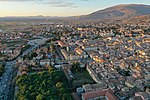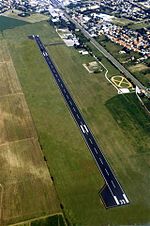Giostra della Quintana
FolignoHistorical competitions of ItalyItalian traditionsTheatrical jousting

The Giostra della Quintana was a historical jousting tournament in Foligno, central Italy. It was revived as a modern festival in 1946. The tournament event takes place in June (1st Challenge) during a Saturday night and September (the counter-challenge) the 2nd or 3rd Sunday of September, and is proceeded each time by a festival with a 17th-century costumed parade.
Excerpt from the Wikipedia article Giostra della Quintana (License: CC BY-SA 3.0, Authors, Images).Giostra della Quintana
Viale Luigi Chiavellati,
Geographical coordinates (GPS) Address Nearby Places Show on map
Geographical coordinates (GPS)
| Latitude | Longitude |
|---|---|
| N 42.95188 ° | E 12.70538 ° |
Address
Campo de li Giochi - Marcello Formica e Paolo Giusti (Campo dei giochi)
Viale Luigi Chiavellati
06034
Umbria, Italy
Open on Google Maps







